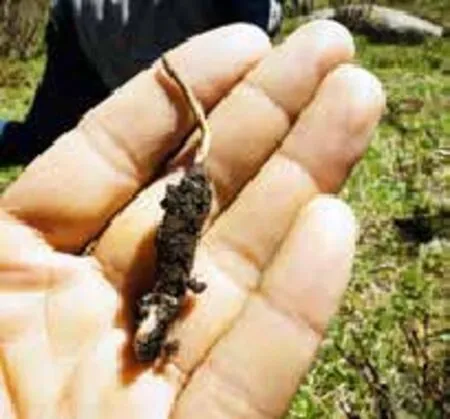GRASSLAND PAINS
BY LIU SHA (刘莎)
GRASSLAND PAINS
BY LIU SHA (刘莎)

Homemade harvests hurt the plains
冬虫夏草的“神效”背后是千疮百孔的草原
Every May, people living in the Tibet Autonomous Region as well as Qinghai and southern Gansu provinces, head to the grasslands looking for “soft gold”, AKA “Himalayan Viagra”—a remarkable species of parasitic fungus that specifically requires one kind caterpillar to act as host. The hunt will last until July, when the hunters are sure they’ve exhausted their quarry.
The “caterpillar fungus”, or “winter worm, summer grass” (冬虫夏草),colloquially known as chongcao, is found within ghost moth caterpillars. In summer, the infected caterpillars die and the fungus breaks free to release its spores. The result is a desiccated bug lying on the ground with a twig of fungus sticking out of it. In China, such plants only grow on the Qinghai-Tibetan Plateau between 3,500 and 5,000 meters above sea level. For farmers and herders living in Tibet, Qinghai, northern Sichuan,and southern Gansu Province,searching for this fungus is an important, lucrative skill.
Due to limited production and the item’s exaggerated healing effects, the price of chongcao has skyrocketed and keeps increasing every year—only dropping a small bit during the anticorruption campaign. At the Beijing Tongrentang pharmacy, quality chongcao is sold at 4,299 RMB for every ten grams, even more expensive than the price of gold. But in the 1980s, the price was only around 50 yuan for 500 grams.
While people pay a higher price for this magical herb meant to cure everything from bronchitis to cancer, it is exacting an even higher environmental toll on the grasslands of the Qinghai-Tibetan Plateau.
Heavy speculation has lured outof-towners, all hoping to hit fungus pay dirt. Every day they bring hoes and trowels and hunch forward in the grass, looking for the elusive fungus.
To get an intact specimen out of the mud (the broken ones are worth much less) the digger will scoop out the soil surrounding the herb in order to preserve it for transportation. While this medically unimportant fungus may very well be in tip-top condition,there’s a problem—namely the massive hole in the grasslands.
Every chongcao that’s torn from the ground means a spread of turf around 30-square-centimeters that is damaged. That may not sound like a great deal in the grand scheme of things, but, in Tibet alone, the annual production in 2015 was 63 tons of chongcao.
There is an unexpected side-effect to these tiny holes: they increase in size over time. It is said that, in the 1960s,Shen Nanying, a pioneer of biological research into the cultivation of artificial chongcao, dug a fist-size hole in the grassland of Yushu, Qinghai Province. Twenty years later, the hole had grown to the size of a bowl.
Grasslands are famous for their flat surfaces, and as such, erosion,geology, and a number of other factors conspire to increase the size of these small holes, a process that could spell disaster for the grassland’secosystem. Grass does not grow back around these holes and too many concentrated in one area could lead to desertification, loss of migratory species, and even a rodent problem.
But this, in all honesty, is not the greatest mark left on the lands of the plateau; the people who hunt this caterpillar need to cook and live on the grasslands—often involving hours of walking or driving around to get an intact chongcao. During the process,grass is trampled, fumes leak into the skies, and garbage is left helter-skelter.
Yang Darong, a researcher with the Chinese Academy of Sciences,estimates that every year around 2 to 3.5 million square meters of grassland is affected by digging activity due to the chongcao.
The ecological environment of the Qinghai-Tibetan Plateau is quite fragile due to the high altitude. Vegetation penetration is no deeper than 20 centimeters, but diggers have to go eight to 14 centimeters for chongcao and that causes severe damage to the grassland, says Xie Yan, researcher at the Institute of Zoology, Chinese Academy of Sciences.
In Tibet, over one third of the grassland has degenerated and ten percent has suffered desertification;the hunt for chongcao exacerbates the current problems of global climate change, mining, and over-grazing of herd animals, according to a report by the Institute of Applied Ecology of the Chinese Academy of Sciences.
And while this might seem like a problem that’s worlds away for many,it hits surprisingly close to home for those in the East. Severe water erosion, desertification, and drought have greatly decreased the flow of water in streams that originate from the plateau such as the Yellow River,Yangtze River, and Lancangjiang (the upper reach of the Mekong),Xie says.
“No one’s saying that we cannot make use of the chongcao resources but we have to be careful with the way we dig them out,” she added. Jamyang, a businessman in Naqu,Gannan Tibetan Autonomous Prefecture, sells traditional Chinese medicine (TCM) including chongcao on Taobao. He told TWOC that he and his staff control the number of fungi they dig and make sure to bury the mud and turf back to protect the grassland.
“My family started a chongcao business during my grandparents’generation. The resources are a treasure of our grassland and rural Tibetans rely on them. Traditionally,Tibetan people didn’t root out all the stalks in an area to make sure there were some left to spread their spores,” he said.
Besides the ecological damage,overharvesting also threatens the sustainability of medical resources. A Xinhua report in 2005 said that half of the Tibetan farmers’ and herders’income is from chongcao. In order to protect their interests, in 2005 both Qinghai and Tibet started issuing permits to collect the fungus, hoping to limit the number of collectors. But this has had very little effect. Some businessmen started contracting so that they can operate in their spheres regardless of allowances and time limit.
Li Hui, a botanist from the Biology Research Institute of Tibet, suggests the government should do more research to locate the distribution of the fungus resources and set offlimits areas that are closed until the grasslands have an opportunity to recover. But sadly, just east of Tibet in Inner Mongolia’s Hulun Buir Grassland, regulations and laws don’t seem to work.
Though they lack the chongcao,the Hulun Buir Grassland is a rich resource for herbs and so it suffers similar problems.
The root of Saposhnikovia divaricata,or in Chinese fangfeng (防风) is supposed to be a TCM herb that can ease headaches and arthritis, and the tool that’s used to collect fangfeng is a 120-centimeter-long steel shovel. Collectors dig a furrow with a radius of 30 to 40 centimeters, bigger than the small ones used for grass worms. In order to avoid law enforcement officers, collectors usually put the herbs in a jute bag and bury them in nearby pits, retrieving them at a later date. For herders these pits are like traps—humans and horses alike step in them to dangerous effect.
The local government of Hulun Buir has been cracking down on illegal collection, and in 2012,the Inner Mongolian government regulated that TCM herb collectors must take responsibility to restore the grasslands they damage. In fact,another provision in the Grassland Law also says that damaging over 20 mu (about 13,333 square meters) of grassland is now a criminal offense. However, in the vast grassland, it is basically impossible to monitor what turf was affected and who did it.
Part of the problem of enforcement lies in resources. The law enforcement officers for this sort of thing belong to the “Grassland Administration Department”,which is managed by the Animal Husbandry Department under the Ministry of Agriculture. They are poorly-equipped and vastly outnumbered, only capable of issuing warnings and fines—a poor punishment for men and women on the grassland with no money on hand.
Be it the fangfeng of Inner Mongolia or the fungus of Tibet, a lack of regulation for harvesting wild TCM ingredients is becoming a problem for environmentalists and the natives of the grasslands.

